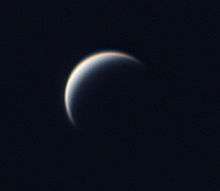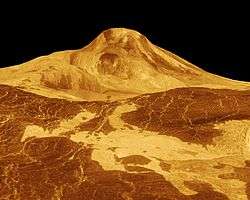Venera 14
| Mission type | Venus flyby / lander |
|---|---|
| Operator | Soviet Academy of Sciences |
| COSPAR ID | 1981-110A |
| SATCAT № | 12939 |
| Spacecraft properties | |
| Spacecraft type | 4V-1 No. 761 |
| Manufacturer | NPO Lavochkin |
| Launch mass | 4,394.5 kg (9,688 lb) |
| Landing mass | 760 kilograms (1,680 lb) |
| Dry mass | 1,632.71 kilograms (3,599.5 lb) |
| Start of mission | |
| Launch date | November 4, 1981, 05:31:00 UTC |
| Rocket | Proton with upper and escape stages |
| Launch site | Baikonur 200/39 |
| Flyby of Venus | |
| Spacecraft component | Venera 14 flight platform |
| Closest approach | March 5, 1982 |
| Venus lander | |
| Spacecraft component | Venera 14 descent craft |
| Landing date | March 3, 1982, 07:00:10 UTC |
| Landing site | 13°15′S 310°0′E / 13.250°S 310.000°E (east of Phoebe Regio) |
Venera 14 (Russian: Венера-14 meaning Venus 14) was a probe in the Soviet Venera program for the exploration of Venus.
Venera 14 was identical to the Venera 13 spacecraft and built to take advantage of the 1981 Venus launch opportunity and launched 5 days apart. It was launched on 4 November 1981 at 05:31:00 UTC and Venera 13 on 30 October 1981 at 06:04:00 UTC, both with an on-orbit dry mass of 760 kg.
Design
Each mission consisted of a cruise stage and an attached descent craft.
Cruise stage
As the cruise stage flew by Venus the bus acted as a data relay for the lander and then continued on into a heliocentric orbit. It was equipped with a gamma-ray spectrometer, UV grating monochromator, electron and proton spectrometers, gamma-ray burst detectors, solar wind plasma detectors, and two-frequency transmitters which made measurements before, during, and after the Venus flyby.
Descent lander
The descent lander was a hermetically sealed pressure vessel, which contained most of the instrumentation and electronics, mounted on a ring-shaped landing platform and topped by an antenna. The design was similar to the earlier Venera 9–12 landers. It carried instruments to take chemical and isotopic measurements, monitor the spectrum of scattered sunlight, and record electric discharges during its descent phase through the Venusian atmosphere. The spacecraft utilized a camera system, an X-ray fluorescence spectrometer, a screw drill and surface sampler, a dynamic penetrometer, and a seismometer to conduct investigations on the surface.
List of lander experiments and instruments:[1]
- Accelerometer, Impact Analysis - Bison-M
- Thermometers, Barometers - ITD
- Spectrometer / Directional Photometer - IOAV-2
- Ultraviolet Photometer
- Mass Spectrometer - MKh-6411
- Penetrometer / Soil Ohmmeter - PrOP-V
- Chemical Redox Indicator - Kontrast
- 2 Color Telephotometer Cameras - TFZL-077
- Gas Chromatograph - Sigma-2
- Radio / Microphone / Seismometer - Groza-2
- Nephelometer - MNV-78-2
- Hydrometer - VM-3R
- X-Ray Fluorescence Spectrometer (Aerosol) - BDRA-1V
- X-Ray Fluorescence Spectrometer (Soil) - Arakhis-2
- Soil Drilling Apparatus - GZU VB-02
- Stabilized Oscillator / Doppler Radio
- Small solar batteries - MSB
Landing
After launch and a four-month cruise to Venus the descent vehicle separated from the bus and plunged into the Venusian atmosphere on March 5, 1982. After entering the atmosphere a parachute was deployed. At an altitude of about 50 km the parachute was released and simple airbraking was used the rest of the way to the surface.
Venera 14 landed at 13°15′S 310°00′E / 13.25°S 310°E (about 950 km southwest of Venera 13) near the eastern flank of Phoebe Regio on a basaltic plain.
The lander had cameras to take pictures of the ground and spring-loaded arms to measure the compressibility of the soil. The quartz camera windows were covered by lens caps which popped off after descent. Venera 14, however, ended up measuring the compressibility of the lens cap, which landed right where the probe was to measure the soil.[2]
The composition of the surface samples was determined by the X-ray fluorescence spectrometer, showing it to be similar to oceanic tholeiitic basalts.
The lander survived 57 minutes (the planned design life was 32 minutes) in an environment with a temperature of 465 °C (869 °F) and a pressure of 94 Earth atmospheres (9.5 MPa). Telemetry had been maintained by means of the orbiting bus that carried signals from the lander's uplink antenna.[3]
Fictional references
- Venera 14 is visited by a Russian cosmonaut in BBC's Space Odyssey: Voyage To The Planets.
Image processing
American researcher Don P. Mitchell has processed the color images from Venera 13 and 14 using the raw original data.[4] The new images are based on a more accurate linearization of the original 9-bit logarithmic pixel encoding.
See also
References
- ↑ Mitchell, Don P. "Drilling into the Surface of Venus". Retrieved 13 April 2013.
- ↑ Images available at http://www.donaldedavis.com/2003NEW/NEWSTUFF/DDVENUS.html
- ↑ http://nssdc.gsfc.nasa.gov/nmc/spacecraftDisplay.do?id=1981-110D
- ↑ The versions currently available on Mitchell's website
External links
| Wikimedia Commons has media related to Venera 14. |


